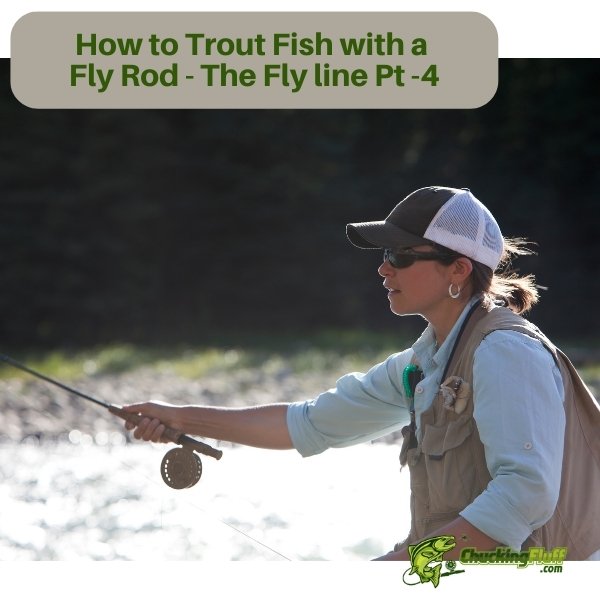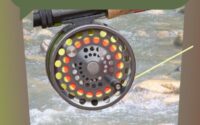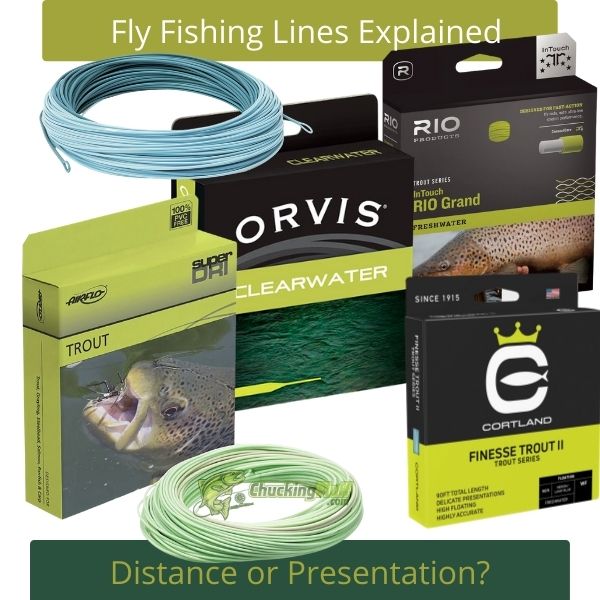| Disclosure: Just to be open and honest the buttons and links you click on in the website will in most cases take you to another website where you can purchase the products I am reviewing. As an Amazon Associate I earn from qualifying purchases. |
How to Trout Fish with a Fly Rod – Part four, the Fly Line
In the last post we looked at the fly fishing reel which holds the fly fishing line.
The fly line is the part that takes the flies out into the water so we can catch fish and trout.
In traditional bait and spin fishing the line either monofilament, fluorocarbon or braid, is a lot thinner and more supple than the fly fishing angler line.
The fly line is usually much thicker, comes in many colors and is about 30 yards long.
When correctly matched to the fly rod and reel the line allows us to cast our flies out onto the water with an action that lifts many yards of line at a time, forces it behind us and then out again onto the water.
This action called the overhead fly fishing cast is the basic form of fly fishing and the one most practiced.
OK, that’s the basics let’s see what to look out for when learning how to trout fish with a fly rod using a fly line.
There are many permutations to fly line and this seems to increase every year as manufacturers develop new enhancements for us to try on our favorite waterways and rivers.
Fly lines come in different weights, colors, densities and multi-variations of the same.
Let’s look at these in order to discover the differences and how they can affect fishing performance.
Fly Fishing Line Weight:
As already mentioned in previous posts manufacturers have developed the AFTM method for measuring fly rods, reels, and lines.
These ratings are usually stamped on the fly rod butt and now on new reels and lines.
It is important to match these rating as you build your setup to make life easier when trying to cast the fly line.
As we have looked at a 5 weight system we will continue here with the same.
This rating means a rod of size 5 will cast a fly line of size 5 fairly easily without a lot of extra effort.
This means the setup is balanced and makes life easy for newbies when purchasing new equipment.
If you follow the labels correctly you will get up and going very quickly.
Just because these ratings exist it doesn’t mean that a 10 rated fly rod will not cast a 3 rated fly line because it will.
However, it takes more experience to know how to load the rod correctly so you can make half-decent casts, something a newbie is not going to have, so a waste of time and energy.
It is much better to follow the ratings.
What Colors do Fly Fishing Lines come in?
Fly fishing lines now come in all sorts of colors, ranging from black to high-visibility luminous yellow and orange.
Some will say that fly line color is down to taste and that is true but I would suggest staying away from bright colors when fishing for easily spooked fish.
You do not want to make your task of landing trout any harder than it needs to be.
There are also lines on the market now that come in camouflage colors these can add an extra level to your stealth approach when fishing for wild brown trout or other easily spooked fish.
Personally I find if you are using a long enough leader and working the water in front of you in a systematic approach you shouldn’t spook any fish.
What I mean is cast close to you first in the clockwork positions of a clock working from 9 around to 3 then add a bit more length to your cast and do again.
Keep increasing until you have reached your maximum cast. If you do this you will make sure
a) not to spook any close fish with the line and
b) cover all available fish in your area.
I have fished with all colors and don’t have a preference although I do like the stealth tip lines available were the last 15 feet or so is clear making it a great versatile line.
I have had much success with this line.

What is a Fly Line Density?
The concept of line density can be a bit confusing for some anglers so I will try and inform you of what I know.
The line density is the way a fly line behaves in the water column.
A full floating fly line does exactly that and will float all day no matter what the conditions.
You can bring your flies down a bit in the water by weighing the leader and using weighted flies but the main fly line will still mostly float.
Then comes intermediate lines. These lines sink at a very slow rate ranging from 0.5 – 2 inches per second and some (hover type lines) otherwise known as neutral density lines will just sit below the water surface.
These lines are great for using on windy days as they are less likely to be caught by the wind and blown across the surface and hinder our fly fishing.
These intermediate lines will fish on windy days a lot longer giving us a better chance of catching more fish.
When trout fishing I always make sure I carry an intermediate line with me.

Then there are an array of faster sinking fly lines ranging from 2 inches per second sink rate and up.
These lines will help take your flies down in deep water to where the fish are feeding.
It’s not much fun casting a full floater to fish that are feeding twenty feet down.
Your chances of takes are going to be low, better to get the flies down to the fish and use a medium to fast sinking line to do that.
Other advantages are fishing fast flowing water when the fish are sitting close to the bottom staying away from the current.
To get to them quickly you need a fast sinking line to take the fly down before you have swung down stream and missed it.

These lines are dependent on the water flow and depth. If you are getting down too quickly your flies will catch the bottom of the river and get snagged where you can possibly lose them.
Not much fun as it takes time to retie another one on and costly if you do it often.
Better to move up a density and make the line sink at a slower rate as it swings in the current.
These techniques are something you can learn over time.
There are also combination lines now available where there are 2 or 3 densities built into the line.
Guideline product a triple density fly line where it sinks at 3 different rates at an angle.
For example the tip will be medium sink the head intermediate and the belly will be floating.
This gives the angler the impression of poking a long stick into the water with the fly at the desired depth and having perfect feel for any takes on the line.
This in contrast to a line that will sink unevenly and may have a bow to it or undulation that leaves the angler out of touch with the fly and takes are harder to feel.
These lines are a great addition to any arsenal but do cost a bit more.
Would love to hear your thoughts on what makes a A Good Fly Line and what are your favorites.




Was looking forward to the next installment Mark and you haven’t disappointed, another clear and concise piece in the series.
I like the rating system, definitely the way to go for a newbie like myself.
So am I right in thinking that the 7 rate system is the best for a newbie to go with? I’m thinking along the lines of it for some basic river trout fishing, hopefully nothing too complex to get me started.
Colm I choose a 7 rated setup as the best all rounder. If you are only interested in fishing for river trout of a certain size say up to 2-3lbs as they are in the Irish rivers I would suggest a 5 or 6 weight setup. A 7 will give the extra strength for larger species like summer Salmon or Jack Pike if you thought you would try for these too. If not and its trout only then the smaller setup will give you light gear that makes playing smaller trout more fun and exciting.